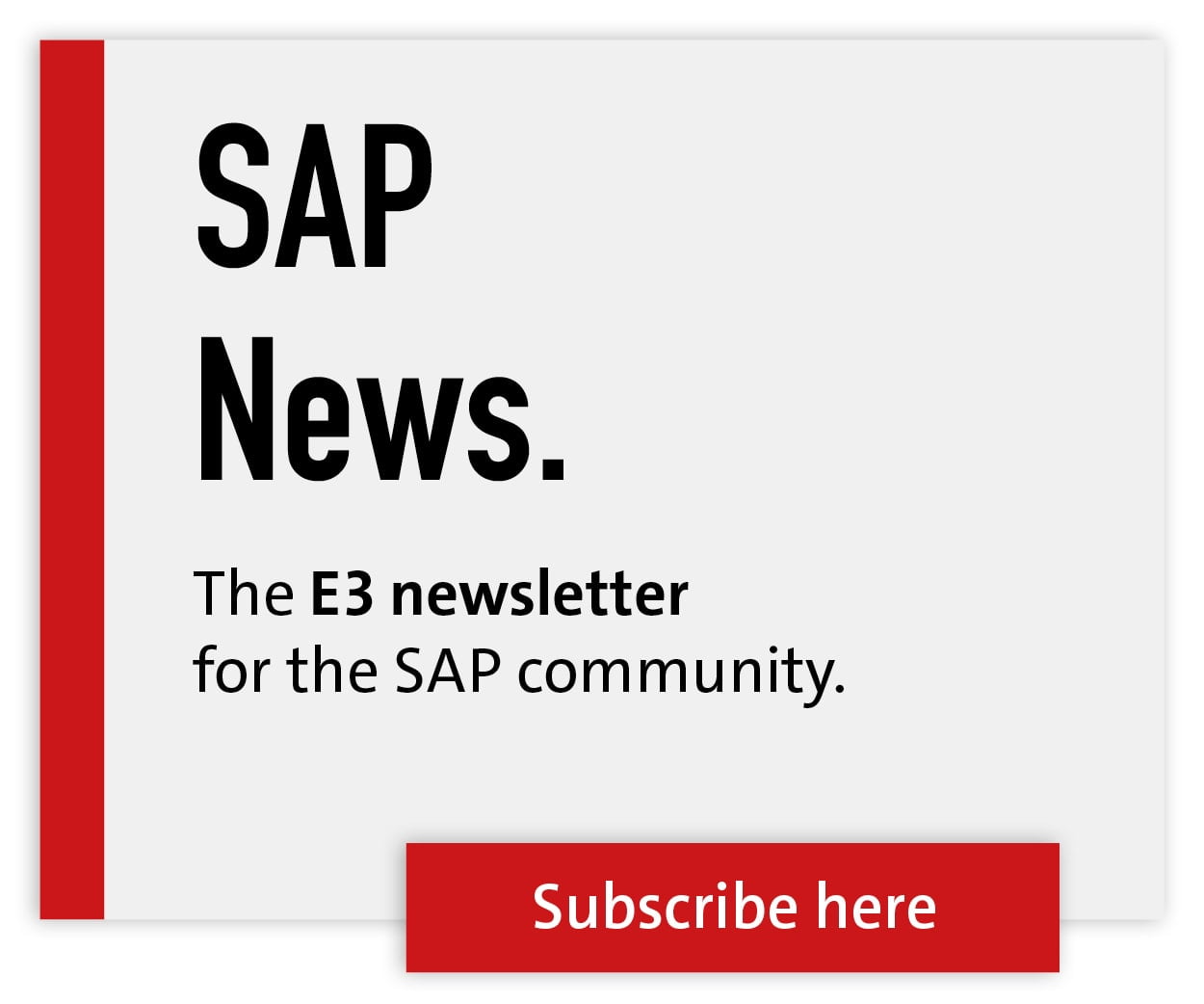Optimized SAP processes in ten Scrum sprints


The biggest project challenges were to link SAP R/3 and SAP S/4 Hana and to consolidate material master and MCAD inventory data.
The first was carried out in the SAP standard using Application Link Enabling (ALE), which transfers data asynchronously. In order to obtain consistent information, it was necessary to meticulously synchronize the data flows and incorporate technical checks without disrupting ongoing operations. Both tasks, as well as the consolidation of the data, were achieved through teamwork. The data had to be selectively checked, cleansed and transferred from three different sources into the new system. In the new system, the master data then had to be converted and MCAD data enriched with additional information. The ALE interface, a migration tool from SSE and two tools from Cideon helped with all of this: PDM import and SAP ECTR data enrichment.
Seamless engineering integration
This meant that all data was integrated into S/4 Hana. The MCAD team can manage documents and materials without redundancy and logically linked. Thanks to SAP features such as DMS, change management or status network, it can create, release and change documents with system support - with automatic versioning and recording of maturity levels and validity. In addition, 3D models, drawings etc. are protected against parallel processing.
This was made possible by standard software that seamlessly integrates authoring tools with SAP's PLM software: On the one hand, the SAP ECTR integration platform from DSC with included MS Office interface, and on the other hand, the associated CAD direct interface SAP ECTR interface to Solidworks from Cideon. DSC and Cideon worked hand in hand on implementation and customizing.
Release through business rules
Release and change processes at SSE were secured by business rules. Thanks to an add-on from DSC, this could be done without any programming. This ensured that MCAD documents, for example, can only be released if they fulfill certain requirements. The release of a superordinate document automatically leads to the release of its subordinate documents. An assembly release is only possible once all associated components have been released.
After release, the previous version automatically loses its validity and new versions must be based on the last valid version and have a change number. This guarantees complete version packages with consistent content and data consistency across versions in the event of changes. In the past, the MCAD team needed Word forms for change management in addition to its Solidworks documents.
Time savings for the MCAD team
In addition, Excel material master sheets were maintained due to the lack of access to the master data in SAP R/3. Document numbers were assigned manually, for which the MCAD team maintained several number ranges.
CAD drawings and 3D models also had to be converted into neutral formats and provided to the purchasing department as ZIP files. The MCAD team jumped back and forth between tools, systems and file folders to create, copy and store files or to synchronize and update data. Sometimes work was carried out multiple times because the maturity levels and validity of CAD documents were not apparent. This resulted in an enormous amount of unnecessary work that wasted valuable time.
The MCAD team currently manages documents and material masters conveniently in SAP S/4 Hana, which is linked to the SAP R/3 ERP system. In addition to MS Office, Solidworks is also seamlessly integrated - via SAP ECTR from DSC and SAP ECTR interface to Solidworks from Cideon. The design process is also mapped in SAP via SAP ECTR. This allows the MCAD team to benefit from time-saving PLM functions directly in their design environment and quickly access accurate data via keywords. In-depth SAP knowledge is not required, as everything can be used intuitively.
SAP automatisms
Thanks to the SAP system, processes such as the following can now run automatically:
Numbering documents and filling their headers, creating document info records that provide information about the status, validity or links of a document, compiling version packages based on change numbers, redundancy-free and structured storage of all data.
The software from DSC and Cideon provides further intelligent process support. Thanks to SAP ECTR, documents can be linked with each other and with materials and material parts lists can be generated automatically - even for variants with the help of a demand-optimized data model. And as an add-on, the Cideon Conversion Engine generates all the necessary neutral formats and ZIP files for subsequent processes. All this is done much faster than manually and in reliable, consistently high quality.
The MCAD team can access the SAP ECTR user interface from Solidworks with a single click. The intuitive UI enables users to work with familiar folders, windows and icons, an embedded viewer and many practice-optimized convenience features. Users can organize their SAP data as required. Among other things, this makes it possible to map product structures and navigate graphically through assemblies, track the status of projects and documents, display object details and change histories, view product-relevant data in consolidated form - including ERP information, which is now accessible via a trusted link. The MCAD team is proud of the result: full transparency with minimal administrative effort.
The data for product changes for ERP processes used to be provided manually. These were, for example, MCAD documents, 2D/3D neutral format files for suppliers and material master sheets for maintaining master data such as plant parts lists. Changes in progress were not visible in the R/3 system, nor was the CAD document on which a supplier order was based displayed. Neutral format files were attached to an ordered SAP material, but no 2D/3D viewables that could have been viewed in the SAP 3D Visual Enterprise Viewer SAP 3D VEV.
SAP-supported PDM
Thanks to the integration solution from DSC and Cideon, mechanical product management now runs system-supported in SAP S/4 Hana - with controlled release and change processes. Related documents such as MCAD documents, material master data and the automatically generated material parts lists and neutral formats are now logically linked. The unique Engineering Change Number (ECN) guarantees version packages with consistent content. There is also a data interface between S/4 and SAP R/3, which has been implemented with SAP Application Link Enabling SAP (ALE).
All of this enables a cross-system change process that extends into production. In the case of SSE, it was important to note that production often still needs the previous plant BOM, e.g. for remaining work, despite an adjusted group BOM, e.g. for a new product version. In order to be able to implement the planned quantities logistically, the plant BOM must have a data entry date, i.e. an update date, in the future. DSC and Cideon overcame this challenge by using two separate, logically linked change numbers.
The first is the ECN from S/4, to which the respective version package is attached and which documents the validity of the development. Secondly, there is a logistics change number that only applies in SAP R/3, where it is used to maintain the plant BOM. This ensures that every released product change now flows automatically into the ERP system. This means that purchasing and logistics always have access to reliably up-to-date and valid data. Product development can immediately create the next version, and when logistics is ready, the workpiece lists are automatically updated with the correct data. In engineering, the Cideon Conversion Engine generates the neutral formats including 2D/3D viewables for SAP 3D Visual Enterprise Viewer.
Trusted Link
On the ERP side, every SAP material ordered is now also linked to viewables and CAD documents. And from SAP R/3, it is possible to access information in SAP S/4 Hana via a trusted link based on authorization. Thanks to these innovations, suppliers automatically receive the right files - always in high quality.
Now everyone involved in the process has access to CAD originals. The order clearly shows which CAD part is involved and the CAD document shows which orders have been placed for the respective part. Another advantage: purchasing and logistics can find out about upcoming product changes at an early stage.
Seamless traceability
The result: the new solution has not only created a standardized information basis for all PEP participants, but also makes it possible to trace every product seamlessly - from the workpiece list to the material order to the MCAD document.
Schubert System Electronics
As a computer technology expert, Schubert System Elektronik, SSE, supplies innovative solutions for Industry 4.0 - from sensors to IoT concepts in the cloud. With more than 50 years of expertise, the company develops and manufactures individual and series products in Germany for industrial fields such as mechanical engineering and medical technology: from hardware and software to assemblies and complete systems.
Integration is a business issue at SSE, and not just in the customer business. The major internal goal is to integrate mechatronic product development into SAP. In a Scrum project with DSC and Cideon as integration partners, SSE has now mastered the first stage. The company's headquarters are located in Neuhausen ob Eck in Baden-Württemberg. As a member of the Gerhard Schubert Group, SSE is part of a globally active family business with over 1600 employees.
Source: Cideon






